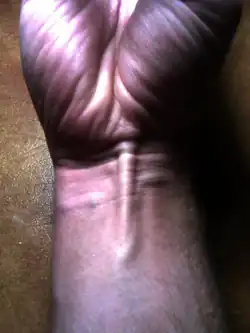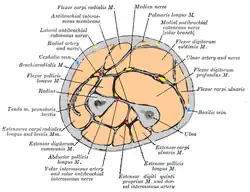Palmaris longus muscle
| Palmaris longus muscle | |
|---|---|
 Palmaris longus tendon as seen in surface anatomy | |
| Details | |
| Origin | medial epicondyle of humerus (common flexor tendon) |
| Insertion | palmar aponeurosis and flexor retinaculum of the hand |
| Artery | ulnar artery |
| Nerve | median nerve |
| Actions | wrist flexor |
| Antagonist | Extensor carpi radialis brevis, Extensor carpi radialis longus, Extensor carpi ulnaris |
| Identifiers | |
| Latin | musculus palmaris longus |
| Greek | Μακρύς παλαμικός μυς |
| TA98 | A04.6.02.029 |
| TA2 | 2482 |
| FMA | 38462 |
| Anatomical terms of muscle | |
The palmaris longus is a muscle visible as a small tendon located between the flexor carpi radialis and the flexor carpi ulnaris, although it is not always present. It is absent in about 14 percent of the population; however, this number can vary in African, Asian, and Native American populations.[1] Absence of the palmaris longus does not have an effect on grip strength.[2] However, the lack of palmaris longus muscle results in decreased pinch strength in fourth and fifth fingers. The absence of palmaris longus muscle is more prevalent in females than males.[3]
The palmaris longus muscle can be seen by touching the pads of the fourth finger and thumb and flexing the wrist. The tendon, if present, will be visible in the midline of the anterior wrist.
Structure
Palmaris longus is a slender, elongated, spindle shaped muscle, lying on the medial side of the flexor carpi radialis. It is widest in the middle, and narrowest at the proximal and distal attachments.[4]
It arises mainly from the medial epicondyle of the humerus via the common flexor tendon. It also takes origin from the adjacent intermuscular septa and from the antebrachial fascia.[4]
It ends in a slender, flattened tendon, which passes over the upper part of the flexor retinaculum and inserts onto the central part of the flexor retinaculum and lower part of the palmar aponeurosis. Frequently, it sends a tendinous slip to the short muscles of the thumb.[4]
Nerve supply
The palmaris longus is supplied by the median nerve.[5]
Variation

The fleshy belly occasionally migrates distally and comes to lie close above the wrist, as here.
Palmaris Longus was absent in 98 of 716 dissected limbs (i.e., in 13.7% of 358 paired limbs, 26 times in both limbs, 26 in the right only, and 20 in the left only. (R. K. George).[6]
The palmaris longus muscle is a variable muscle. The most common variation is its absence. Several in vivo and in vitro studies have documented the prevalence or absence of the PL tendon in different ethnic groups. Between 5.5 and 24% of Caucasian populations (European and North American) and 4.6 to 26.6% of Asian populations (Chinese, Japanese, Indian, Turkish, Malaysian) have been reported to lack the PL tendon.[7]
There are also variations related to its form. It may be tendinous above and muscular below; or it may be muscular in the center with a tendon above and below; or it may present two muscular bundles with a central tendon; or finally it may consist solely of a tendinous band. The muscle may be double, or missing entirely. Slips of origin from the coronoid process or from the radius have been seen. Partial or complete insertion into the fascia of the forearm, into the tendon of the flexor carpi ulnaris and pisiform bone, into the scaphoid, and into the muscles of the little finger have been observed.
Clinical significance
Use in tendon grafts

The palmaris longus muscle is the most popular for use in tendon grafts for the wrist due to the length and diameter of the palmaris longus tendon, and the fact that it can be used without producing any functional deformities. When a tendon becomes ruptured in the wrist, the palmaris longus tendon may be removed from the flexor retinaculum and grafted to take the place of the ruptured tendon. The tendons most commonly replaced or supplemented by the palmaris longus tendon when ruptured are the long flexors of the fingers and the flexor pollicis longus tendon.[8]
The palmaris longus muscle itself is a weak flexor, and provides no substantial flexing force that would inhibit movement in the wrist if its tendon were cut and moved elsewhere. The palmaris longus may contribute and assist in thumb abduction movements; an action necessary to open the hand.[9][10] If the palmaris longus muscle is not available for harvesting in an individual, the anatomically homologous plantaris muscle in the leg may be taken instead.[11] Using the patient’s own tendon is advantageous, as it does not introduce foreign material into the body.
Carpal tunnel syndrome and palmaris longus variants
Of the known anatomical variants of the palmaris longus, the reverse belly of the palmaris longus may be localized within the carpal tunnel producing symptoms of carpal tunnel syndrome. Knowledge of this variation is important to prevent unnecessary carpal tunnel release surgery, in which the median nerve compression may remain unresolved due to the presence of this palmaris longus variant.[12]
Other animals
Evolution
The evolutionary interpretation of the muscle's absence is that humans inherited the muscle through common descent, and numerous animals that humans share a common ancestor with (such as the orangutan) still actively employ the muscle.[13] Close primate relatives (such as the chimpanzee and gorilla) also do not actively employ the muscle, and hence they also demonstrate the same variability.[14] The common descent principle suggests that at some stage our ancestors employed the muscle actively. The thumb apparatus (and particularly the thenar muscle group) then started developing in the hominin branch, and consequently the Palmaris longus became vestigial. As there is no apparent evolutionary pressure (positive or negative) concerning the muscle, it has remained largely unaffected by evolutionary processes.[15]
See also
References
![]() This article incorporates text in the public domain from page 446 of the 20th edition of Gray's Anatomy (1918)
This article incorporates text in the public domain from page 446 of the 20th edition of Gray's Anatomy (1918)
- ↑ Sebastin SJ, Puhaindran ME, Lim AY, Lim IJ, Bee WH (October 2005). "The prevalence of absence of the palmaris longus--a study in a Chinese population and a review of the literature". Journal of Hand Surgery. 30 (5): 525–7. doi:10.1016/j.jhsb.2005.05.003. PMID 16006020. S2CID 12394636.
- ↑ Sebastin SJ, Lim AY, Bee WH, Wong TC, Methil BV (August 2005). "Does the absence of the palmaris longus affect grip and pinch strength?". Journal of Hand Surgery. 30 (4): 406–8. doi:10.1016/j.jhsb.2005.03.011. PMID 15935531. S2CID 35394120.
- ↑ Cetin, A.; Genc, M.; Sevil, S.; Coban, Y. K. (2013). "Prevalence of the palmaris longus muscle and its relationship with grip and pinch strength". Hand (New York, N.Y.). 8 (2): 215–220. doi:10.1007/s11552-013-9509-6. PMC 3652998. PMID 24426922.
- 1 2 3 Gray's Anatomy (1918), see infobox
- ↑ Drake, Richard L.; Vogl, Wayne; Mitchell, Adam W. M. (2005). Gray's anatomy for students. Philadelphia: Elsevier/Churchill Livingstone. p. 693. ISBN 978-0-8089-2306-0.
- ↑ Grant's Atlas of Anatomy. 1962.
- ↑ Kose O, Adanir O, Cirpar M, Kurklu M, Komurcu M (May 2009). "The prevalence of absence of the palmaris longus: a study in Turkish population". Archives of Orthopaedic and Trauma Surgery. 129 (5): 609–11. doi:10.1007/s00402-008-0631-9. PMID 18418616. S2CID 26235241.
- ↑ Thejodhar P, Potu BK, Vasavi RG (January 2008). "Unusual palmaris longus muscle". Indian Journal of Plastic Surgery. 41 (1): 95–6. doi:10.4103/0970-0358.41125. PMC 2739544. PMID 19753215.
- ↑ Moore, Colin W.; Fanous, Jacob; Rice, Charles L. (27 December 2017). "Revisiting the functional anatomy of the palmaris longus as a thenar synergist". Clinical Anatomy. 31 (6): 760–770. doi:10.1002/ca.23023. PMID 29178622. S2CID 21747288.
- ↑ Moore, Colin W.; Fanous, Jacob; Rice, Charles L. (1 January 2021). "Fiber type composition of contiguous palmaris longus and abductor pollicis brevis muscles: Morphological evidence of a functional synergy". Journal of Anatomy. 238 (1): 53–62. doi:10.1111/joa.13289. PMC 7754940. PMID 32790091.
- ↑ Wheeless, Clifford R (December 2009). "Palmaris Longus Tendon Graft Harvest". Wheeless' Textbook of Orthopaedics. Retrieved February 2012.
{{cite web}}: Check date values in:|access-date=(help) - ↑ DEPUYDT, K. H.; SCHUURMAN, A. H.; KON, M. (2016-08-29). "Reversed Palmaris Longus Muscle Causing Effort-Related Median Nerve Compression". Journal of Hand Surgery. 23 (1): 117–119. doi:10.1016/S0266-7681(98)80241-6. PMID 9571503. S2CID 26397516.
- ↑ "Proof of evolution that you can find on your own body". 17 March 2016.
- ↑ Thejodhar et al, Indian J Plast Surg Vol 41.1 (2008)
- ↑ Maughan et al: The Roles of Mutation Accumulation and Selection in Loss of Sporulation in Experimental Populations of Bacillus subtilis Genetics. 2007 Oct;177(2):937-48